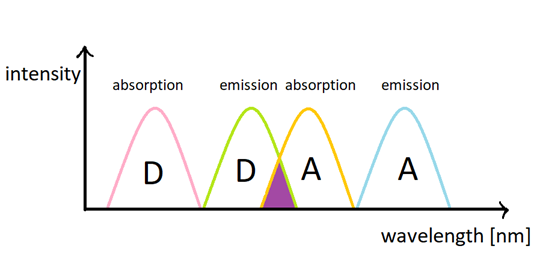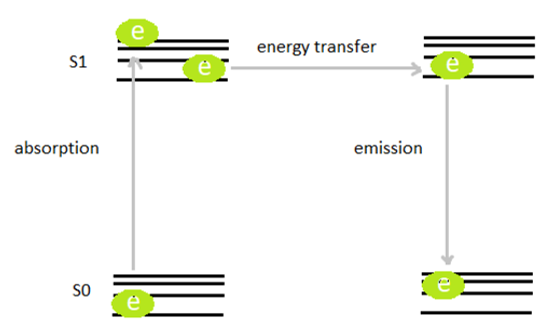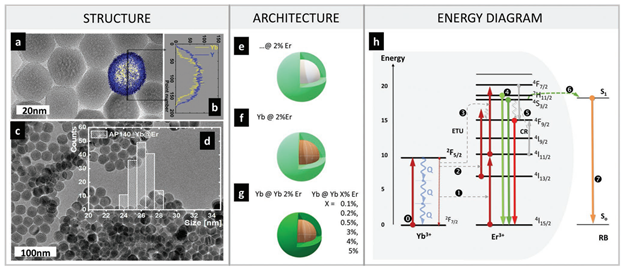Förster Resonance Energy Transfer
Förster Resonant Energy transfer (FRET) is a generic method to study interaction between two fluorescent maieties - the donor (D) and the acceptor (A). Energy absorbed by the donor may be transfered non-raidatively to the acceptor under two circumstances : (1) D emission overlaps spectrally with A absorption (2) D and A stay in close (<10nm) proximity. This 'spectroscopic ruler' phenomenon creates the basis for design of numerous biosensors to study e.g. conformation of proten, enzyme activity, DNA hyrbidisation, antibody-antigen reactions. This methods may be used either for medical diagnostics or in fundamental studies to understand the processes occuring in living cells. Whereas organic fluorophores (dyes, fluorescent proteins etc.) are commonly used for FRET sensing (as D or A), such lables display numerous drabacks, such as (1) photobleaching, of D and A, (2) spectral bleed through between D / A and excitation/emission channels, (3) low signal-to-background signal (D are excited with wavelengths suitable to photoexcited autofluorescence of bio-samples, (4) very short fluorescence lfietimes. LnNP and UCNP circumvent many of these drawbacks, but set new class of challanges, such as many-D-many-A detection, long riseitmes of D photo-luminescence, recharging of D species throught up-conversion process. We aim to study, understand and apply such new UCNPs based bio-detection materials and methods.
Förster Resonant Energy transfer (FRET) is a non-radiative dipol-dipol type energy transfer between the excited state of a luminescent donor and ground state of acceptor molecules. Energy absorbed by the donor may be transferred non-radiatively to the acceptor under two circumstances: D emission overlaps spectrally with A absorption (Fig.1.) and D-A pair stay in close (< 10 nm) proximity.

Fig.1. Spectral overlap between the donor absorption and acceptor emission

Fig.2. FRET mechanism
One of the most important parameters of FRET is its quantum efficiency. This term is defined as the proportion of the donor molecules that have successfully transferred excitation state energy to the acceptor molecules. It increases with decreasing intermolecular distance.

The ΙD and ΙDA are the integrated luminescence intensity of the donor without and with the presence of acceptor molecules. Similarly τD and τDA are luminescence lifetime of donor alone and of the donor accompanied by the acceptor.
Due to inverse 6th power distance dependence, the increased donor to acceptor distances can result in reduced FRET efficiency. To quantify this value experimentally one can measure either luminescence lifetime, donor luminescence intensity drop and acceptor fluorescence (if the acceptor is fluorescent). FRET phenomenon can be described as 'spectroscopic ruler' and creates the basis for design of numerous biosensors to study e.g. conformation of protein, enzyme activity, DNA hybridisation, antibody-antigen reactions. This methods may be used either for medical diagnostics or in fundamental studies to understand the processes occurring in living cells.
Whereas organic fluorophores (dyes, fluorescent proteins etc.) are commonly used for FRET sensing (as D or A), such labels display numerous drawbacks: photobleaching which is photodegradation of organic dye and is caused by laser’s light; very short fluorescence lifetimes which can be the technical problem; autofluorescence which matters especially in case of biological samples – some issues such as blood are spontaneously fluorescent and disrupt the background. Moreover the next disadvantages are spectral bleed through between D/A and excitation/emission channels. The spectroscopic properties of organic dyes also depend on the chemical and biological environment of the molecule, which makes quantitative FRET measurements difficult. UCNP circumvent many of these drawbacks.
This is why we are interested in using lanthanide doped nanoparticles, and especially upconverting nanoparticles (UCNPs) as energy donors in RET based sensors. They have a few tens of nanometers in diameter. They demonstrated an exceptional capability to generate visible or far-red luminescence emission under NIR photoexcitation providing them unique advantages as FRET donors. The example of these compounds is NaYF4: Yb3+, Er3+. The first advantage of them is their high photostability. It is caused by ions Ln3+ because of the fact that 4f orbital electrons are shielded against the influence of the chemical environment by filled 5s and 5p orbitals. The next benefits are narrow emission bands, large anti-Stokes shifts and long decay times of luminescence. The long lifetime of the luminescence is due to the Laporte’s rule forbidden of the transition inside the f-shell. UCNPs are able to emit ultraviolet, visible or near-infrared light after absorbing NIR light.
We aim to study, understand and apply such new UCNPs based bio-detection materials and methods.
We design and the assess the virtual nanocrystal NP (VNP) models which lead to the new designs of UCNPs. Core-shell nanoparticles have an inner core structure and an outer shell made of different components. These particles have been of interest as they can exhibit unique properties. This nanoparticles are experimentally evaluated as donor NPs and compared to the simulations. Our studies help to understand the role of energy-transfer and energy migration between lanthanide ion dopants and how the architecture of core-shell UCNPs affects their performance as FRET donors to organic acceptor dyes. The structure and energy diagram of synthesized core-shell NPs we can see in the picture below (Fig.3). [1]

Fig. 3. The material properties (structure), synthesized core-shell NPs (architecture) and Yb-Er up-conversion based RET (energy diagram). Representative a) TEM, b) TEM-EDS, c) large field-of-view TEM, d) size distribution of Yb@Er Sample. The schematic description of the synthesized NPs: e) undoped-core-active-shell (…@2Er), f) sensitized-core-active-shell (20Yb@2Er), g) sensitized-core-active-shell (20Yb@20Yb2Er, and additional 0.1, 0.2, 0.5, 3, 4, and 5%); h) energy diagram of energy transfer Yb-Er3+ up-conversion based Er-to-RB RET.
We found interesting relationships, which confirm that specially designed core-shell architectures of UCNPs (with donor ions in the shell) are beneficial for UC-LRET sensitivity over conventional UCNPs (where donor ions are evenly distributed in the whole volume). Moreover, we demonstrated that the different photoexcitation scheme, may have their parasitic role in decay based UC-LRET sensing. [2]
Moreover we studied Förster resonance energy transfer between nanoparticles of up-conversion lanthanide crystals as donors and quantum dots as acceptors. We have demonstrated that this system possesses the essential features required for FRET applications. These include high D-A spectral overlap and satisfactory quantum yield of the donor with no acceptor present. Both acceptor emission and donor luminescence lifetime decrease were experimentally demonstrated and were in good agreement with the theoretical Förster distance value.[3]
by Julia Wnętrzak, Agata Kotulska & Artur Bednarkiewicz
REFERENCES:
[1] Aleksandra Pilch-Wrobel, Agata Maria Kotulska, Satu Lahtinen, Tero Soukka, Artur Bednarkiewicz, Engineering the Compositional Architecture of Core-Shell Upconverting Lanthanide-Doped Nanoparticles for Optimal Luminescent Donor in Resonance Energy Transfer: The Effects of Energy Migration and Storage, Small 2022 Institute of Low Temperature and Structure Research PAN, University of Turku
[2] Agata M. Kotulska, Aleksandra Pilch-Wróbel, Satu Lahtinen, Tero Soukka, Artur Bednarkiewicz, Upconversion FRET quantitation: the role of donor photoexcitation mode and compositional architecture on the decay and intensity based responses, accepted in LSA, Institute of Low Temperature and Structure Research PAN & University of Turku
[3] Artur Bednarkiewicz, Marcin Nyk, Marek Samoc, Wieslaw Strek, Up-conversion FRET from Er3+/Yb3+:NaYF4 Nanophosphor to CdSe Quantum Dots, J. Phys. Chem. C 2010, 114, 41, 17535–17541; Institute of Low Temperature and Structure Research PAN & Wroclaw University of Technology


